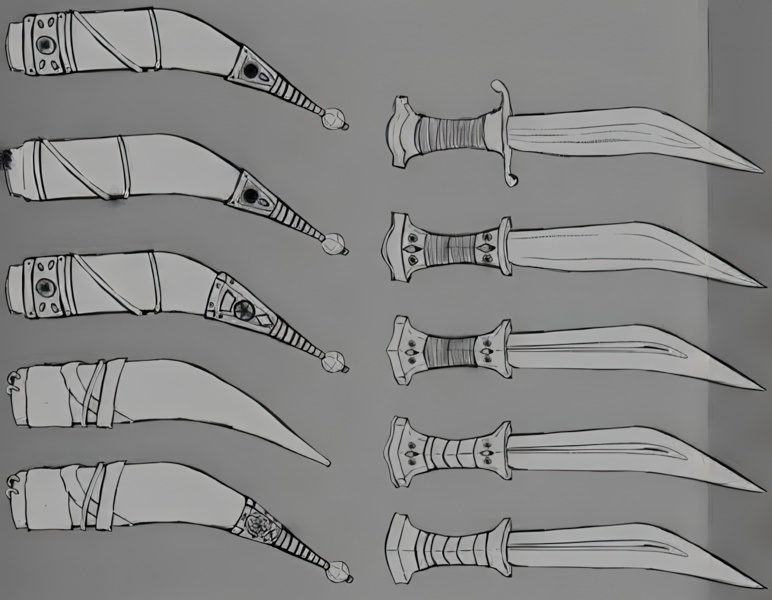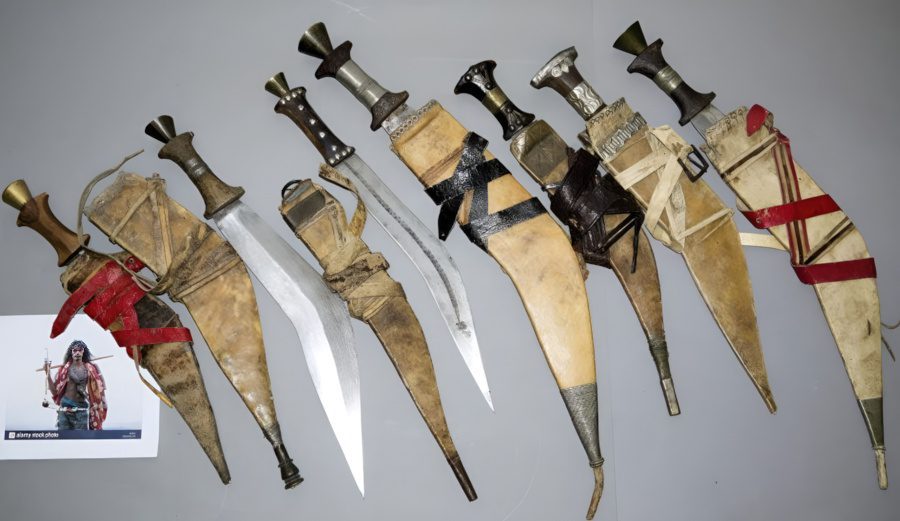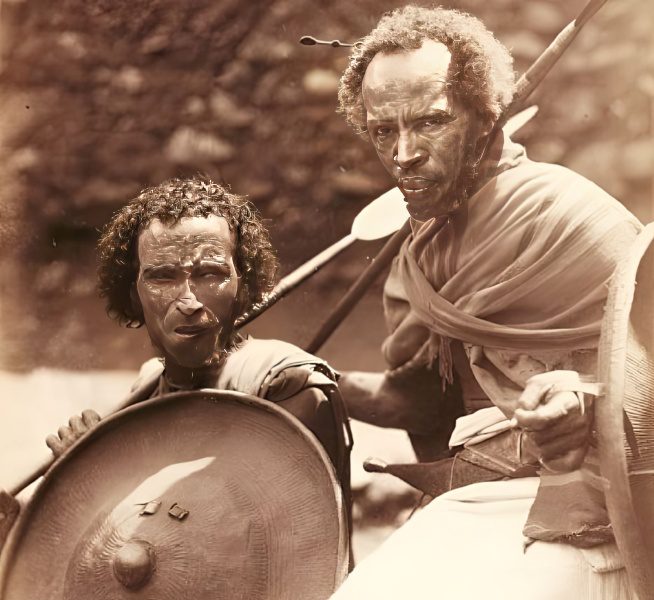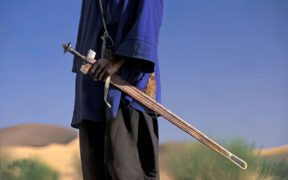Jile Dagger: The Horn-Shaped Blade From the Horn of Africa
NO AI USED This Article has been written and edited by our team with no help of the AI

The Jile Dagger is an African blade with a sickle-shaped curve that looks like a hook or horn, similar to how the Horn of Africa appears on a map. It is called Jile, Gile, or Qolxad in Cushtic, the native language of the Afar people. It is often called a knife, dagger, machete, or shortsword.
The Jile Dagger or sword was often used throughout history and is still used in some African countries today. In this article, we will cover its unique characteristics and explain how they were and still are put to use. Then we will discuss its origins.
Characteristics of the Jile Dagger

The African Jile Dagger is a shortsword resembling a knife due to its small size. Other Jile Daggers are bigger and are larger and used the same as a shortsword. The strongest characteristic of the Jile Dagger is its sickle-shaped curve that resembles the European Sica sword.
Blade

The blade of the curved Jile Dagger is double-edged, meaning sharpened on each edge. The curve is in the form of a sickle, meaning that it has one bigger back ridge on the spine, making the blade curve on the opposite side while also tempering and ending in a very sharp tip. The usual blade length of the Jile Dagger is around 14 inches (35 cm).
Jile blades were usually made of iron, but steel was used when creating the weapon for high-ranking people. It is usually made of salvaged metal like saw blades and other tool metals today. It can feature several fullers or one broad one, opening grooves on the blade to make it lighter and more aesthetically pleasing. Some also feature a mid-rib point.
Guard

Guards are usually metal quillons or pieces just above the handle to protect the user’s hand. Jile Daggers do not feature any type of guard because it is a short blade used together with a large shield. Some see the broadening of the guard’s upper handle as a guard, but this is limited to protective purposes. There are modern Jile Daggers made with a small guard piece.
Handle

The handle of the Jile Dagger is straight and long enough to support one-handed use. The most visual characteristic of this handle is the hourglass shape, which is popular on African swords. The hourglass form gives a firm grip because of the broadening toward the guard and pommel. A common handle length for the Jile is between four and six inches (10-15 cm).
The handle is usually wood and covers the full-tang blade underneath it. The handle is a very important piece of the Jile because the material used and its design explains the person’s social status. Some Jile handles have ivory, rhino, or buffalo horn handles, or at times are made out of silver or wrapped with silver wires and then decorated with rare pearls and metals.
Pommel

The pommel is the ending of the Jile dagger, which holds the finishing of the full-tang blade. There are different types of pommels for the Jile, depending on the type and background of a person’s status. They can be made of wood or silver, be broad and extend from the handle itself or have three teeth or layers of metal like bronze or silver.
This extension of the pommel is used for tying the rope or leather on it when one is carrying the Jile Dagger in its scabbard. It is both a weapon and a part of the uniform for most people and is mostly used for decorative purposes or as a handrest.
Scabbard

The sheath or scabbard of the Jile is curved just the same way as the blade is. Usually, it can feature a mid-rib section to better hold the blade inside. These scabbards can be made of wood, leather, or other hides. Some scabbards, like the pommel design, can be heavily decorated and ornamented with a brass or metal knob.
The Jile inside its scabbard is often worn while tied with rope or cord over the user’s shoulder horizontally with the blade’s tip pointed upwards. The dagger can be worn on the user’s belt and easily unsheathed in combat.
Length and Size

Jile Daggers are primarily smaller knives used as a secondary weapon and an everyday tool. Still, some Jile blades can be sized like the shortsword or Roman Gladius and used as a primary weapon. The most common length for the Jile Dagger is between 12 to 24 inches (30 to 60 cm).
Weight
Despite being of various sizes and shapes, the Jile is a light sword, and this is due to the way it’s created to be an everyday tool that is easily carried. The usual weight for the Jile Dagger is between 0.6 to 0.9 lbs (0.3 to 0.4 kg), leading some people to believe it can be used as a throwable weapon.
Uses for the Jile Dagger
The Jille Dagger is a one-handed weapon that can cut like a machete with the outer sharp edge or slash like a sickle with the inner curve. It can be used as a piercing weapon thanks to its sharp tip. Because of its smaller size, it is an actual sword that can also be used with a reverse grip.
Warfare and Part of Combat Attire

The primary use of the traditional Jile Dagger was as a warfare weapon. It could be carried easily around one’s waist and, depending on its length can be a very effective weapon when used with a shield. There are many historical depictions where it is an effective combat weapon in war or used for everyday self-defense.
The effectiveness of the Jile’s past has made it a traditional combat piece for the Afar people today. It is usually worn on the waist and is only used for defense in life-threatening situations.
Everyday Life

The Jile Dagger is a vital apparatus across the Horn of Africa. The sickle shape of the blade makes it valuable for agriculture, farming, creating roads through thick vegetation, cooking, cutting hair, and carving wood. This shortsword is carried today by men and women and used as an everyday tool or as a self-defense weapon against thieves and criminals.
Prestige

The Horn of Africa was a significant trading center connecting the Arab and the Sub-Saharan African world. Many prestige tools were carried; one such piece was the Jile Dagger worn on the waists of highly decorated individuals. The high position of this blade has made it a distinguished piece that holds the same status in some countries. For example, it is the national symbol of the country of Djibouti.
Traditional and Ceremonial

The Jile was and still is a very live traditional and ceremonial item for the Afar people spanning Ethiopia, Eritrea, Djibouti, and Somalia. It is casually worn and passed from generation to generation as a heritage piece. There are many traditional war sword dances where the Jile is used as the weapon of choice. It can be used as a dowry for weddings, formal events, feasts, and animal sacrifices.
Origin of the Jile Dagger

The Jile or Gile Dagger is an African shortsword or knife that was and still is primarily used by the Afar people in the Horn of Africa regions, modern-day Somalia, Djibouti, Ethiopia, and Eritrea. It is believed the different tribes of the Afar regions are descendants of earlier Arabic people because they are depicted as devoted Muslims beginning in the 13th century.
It is primarily nomadic people that live nearby the eastern coast and sell fish or in the inner areas of the Horn of Africa, selling salt and herding sheep and goats. These regions were well-known for trade in the previous centuries, and primarily traders and visitors from Yemen were seen almost daily.

The dagger has always symbolized prestige, honor, and high status in Yemen. Traders could be spotted across these trade routes going from the Red Sea to the southwest of the Sahara Desert, carrying decorative daggers and swords that inspired many African blades. The Jile Dagger resembles the Jambiya, which is the traditional Yemeni dagger.
This could be the origins of the Jile shape and design or simply from a sickle-shaped tool known as the Khopesh in antiquity. The Jile was and still is a symbol of virility for the Afar people, having been used in different battles in their past, which only increased their ardent and protective nature.





